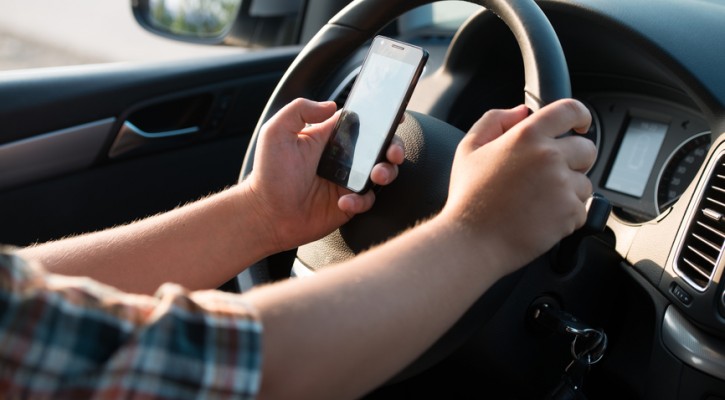Tag Archive: Seat Belt

Top Ten Bad Driving Habits By Teens
March 9, 2014
When teens first start learning to drive, they are usually very careful and willing to listen to advice but, once they get their operator’s license and start driving on their own, some seem to think that all the rules and safe driving advice were just for the driving exam and no longer apply to them. That attitude quickly turns to tragedy for some with an average of six teens killed and 493 injured in traffic crashes every day. More than half of all teen crashes are single vehicle crashes, meaning that, due to high speed or distractions, the teen ran off the road and crashed; no other cars were involved.
The following list of bad teen driving habits isn’t in any particular order. One could be just as bad as another but separately or combined, they are all dangerous.
1. Driving distracted – One of the biggest hazards on the road today is distracted driving. We’ve all heard about the dangers of texting and cell phone use but there are other distractions as well, such as;
- Paying more attention to passengers than to the road ahead.
- Eating and drinking
- Loud music
- Applying makeup
- Looking at things out the window instead of at the road.
- Adjusting the radio or loading CDs
All of these distractions can take your eyes off the road just long enough for a dangerous problem to creep up unnoticed. Continue Reading
Dori Slosberg Foundation Programs That are Saving Lives on our Highways
July 15, 2010
The Dori Slosberg Foundation is a private non-profit public service organization dedicated to traffic safety. It is named after the daughter of State Representative Irv Slosberg, Dori Slosberg, who at 14 was killed, along with four others in a car crash while their seat belts were unbuckled.
The foundation’s mission is to further educate the public about the importance of traffic safety while promoting safe driving habits and helping Florida law enforcement to ensure a risk-free driving environment on roadways. They also support nationwide programs that enable law makers to save lives through legislation. An example of this is the development of the Dori Slosberg and Katie Marchetti Safety Belt Law, which increases the effectiveness of safety belt law enforcement.
Since it was established in 2004, the Dori Slosberg Foundation has developed with several programs and initiatives to provide information on traffic safety including:
Staying Alive on 95, 75 & Florida’s Roadways
Focused on keeping Interstate 95, Interstate 75 and Florida’s roadways as safe for driving as possible, this program brings together concerned individuals and law enforcement to work on innovative ways to keep Florida’s major roadways safer.
DUI 0 Tolerance
This annual brings DUI law enforcement and relatives of DUI victims together, providing an outlet to tell their stories of loss, and reiterating a no-tolerance policy for DUI offenders.
Driver’s Education & Safe Teen Driving Programs
The foundation has set out to form assemblies across the state of Florida which reinforces the value that driving safety begins with proper driver education, before teens even obtain their licenses. They hold conferences for teachers and instructors to create awareness of current resources and technology available for them and to ensure students are getting the quality driver education they deserve. They also reinforce the idea that, before teens get their licenses, they should know about seat belt safety and the dangers of distracted driving.
Safe Senior Transportation
The foundation has been working to find ways to give alternative means of safe transportation for those who are unable to drive due to age or disability. They also provide a one-stop shop for getting elder drivers license renewal and assessment of their driving skills. They also hold a forum for giving safety tips for senior drivers.
Through committed passion and constant attention, these programs and the support of the public have turned the Dori Slosberg Foundation into an influential force when it comes to traffic safety.
How Active Participation Helps Teens Understand Safe Driving Concepts
August 4, 2009
Most adults understand that teens tend to tune out long lectures about safe driving (or anything else), but parents and teachers also know that they have important messages to pass on, and they are sometimes at a loss as to other methods of doing so. Creative thinking in terms of teaching methods, both in the home and at school, can mean the difference between messages that teens will ignore versus those they will integrate into their driving behavior. This is so important with driving; motor vehicle crashes are the leading cause of death for teens in the United States, according to the National Highway Traffic Safety Administration. Obviously, lectures aren’t working.
Recently, First Coast News of Jacksonville, FL profiled four teenagers who had created a Public Service Announcement (PSA) to promote safe driving. The PSA shows a teen driving while listening to music, eating, and using a cell phone to talk and text; she eventually glances at the road just in time to see that it’s too late to avoid a motor vehicle crash.
Reporters quizzed the teens on whether or not they’d ever performed any of these unsafe driving behaviors. The teens admitted to doing so but also said that making the PSA had heightened their awareness of how dangerous these behaviors are, which had caused them to curb the behavior. The teens said that creating the PSA had made the consequences of distracted driving, such as getting into a crash and being seriously injured, seem real. This is more of an accomplishment than one might think; teens’ brains are not biologically developed enough for them to control impulses and understand the consequences of their behavior, which is why convincing them to drive safely is such an uphill battle.
Another benefit of this type of active participation is that these teens became positive role models for their peers, influencing them to drive more safely. Peer pressure is a reality that must not be ignored; many teens perform more (both in intensity and in number) risky driving behaviors when they are accompanied by teen passengers. Whether the teen driver is bowing to external pressure from friends or internal pressure to show off, the effect is the same. The key is not to try to convince teens to disregard peer pressure, an almost impossible task, but to convert the peer pressure into a positive influence.
Making the PSA also had the effect of helping these teens take responsibility for their driving behavior. Again, this is typically a difficult task. Teens have a variety of sources, legitimate and irrational, to blame for their poor choices; reaching maturity means accepting responsibility for their decisions and the attendant consequences, along with realizing that they are the ones who make the ultimate decision to be safe drivers.
Listening to a lecture is a passive process; making a PSA is an active process because it forces the teen to engage with and think about safe driving concepts. Of course, having every teen in America make a PSA about safe driving would be a logistical nightmare, and due to teens’ short attention spans, the experience would soon wear thin. But the concept of having teens participate in an active learning process about safe driving could be utilized in every household and in every school.
Before assigning an active-participation project to teens, consider their interests. Most teens love music, popular television shows, being with friends, and talking about themselves. Most teens are self-conscious about their appearance and are interested in grooming, clothes, and accessories. Many teens also have a special hobby, such as gaming, art, computers, writing, or sports. Many are also interested in exploring new ideas – the perfect time to let them get creative with how to disseminate safe driving messages. Ideas include:
- Designing a poster or series of posters
- Writing a song, using computer software to write accompanying music
- Writing an episode of their favorite television show
- Performing a skit with friends
- Giving their own “presidential address”
- Designing a clothing/accessory line
- Creating a video game
To avoid boredom, vary the topics assigned to the teen, but for maximum benefit, assign topics that relate to common teen driving mistakes, such as:
- Drinking and driving
- Drugs and driving (focus on common drugs of abuse for teens, such as cough medicine, prescription drugs, inhalants, and marijuana)
- Wearing safety belts
- Speeding
- Reckless driving, such as weaving in and out of traffic
- Aggressive driving, such as tailgating
- Distracted driving, such as cell phone use
- Driving with passengers
To further engage their critical thinking skills, have teens present their messages from other points of view. For example, teens who are interested in politics can give a presidential address about enacting laws to lower teen deaths in motor vehicle crashes; teens who are interested in sports can create an advertising campaign showing how drinking and drugs can impair athletic ability. Until the project is finished, try to provide encouragement and support without too much assistance; let teens follow the research and learning process to its logical conclusion.
Helping teens engage in an active learning process regarding safe driving behavior is a requirement for reducing the teen death rate on our nation’s roadways.

Florida Police Officers Worry About Distraction and Safety
April 27, 2007
As the parent of a teenage driver, Police Chief Roger Boatner, of Lakeland, Florida worries when his daughter is behind the wheel. However, his worries are not with her own driving skills or with the locations she visits. He worries most about the many drivers he sees doing nearly everything but driving as they cruise down the street.
Those who spend even a few seconds changing a CD, answering the cell phone, or taking a bite of a sandwich can cause a serious accident. Other troopers agree with the seriousness of the problem of distracted driving. Larry Coggins of the Florida State Highway Patrol claims that in every crash there can be some type of driver error found.
Many studies have been done on the effects of cell phones and other distractions while driving. While exact numbers have varied, the basic results have been the same.
- Virginia Tech’s Transportation Institute found that drivers who talk on cell phones are 4 times more likely to be involved in a serious crash.
- The National Highway Traffic Administration carried out a study, which found that more than 75% of crashes and 66% of near misses occurred when drivers were engaged in conversations on cell phones.
- The University of Utah carried out an experiment that resulted in the conclusion that drivers talking on cell phone were just as impaired as an intoxicated driver.
Results such as these have caused a few states to pass laws prohibiting all drivers from talking on cell phones while behind the wheel. Even more states have implemented similar laws, but focused them only on teenage drivers. Unfortunately, Florida is yet to have created one of these laws.
The Sheriff’s Office in Polk County, Florida has decided that these messages are so important that they have placed them on their phone system as a hold message. Additionally, they remind drivers of the importance of wearing their seat belts.
The Polk Sheriff’s Office handled 50 traffic deaths within their jurisdiction. Of these, officers believe that at least 14 lives would have been saved if the victims had been wearing a seat belt. To prevent more of these accidents from claiming the lives of young people, Florida has enacted a law allowing officers to pull cars over if passengers under the age of 18 years old are seen unrestrained.
